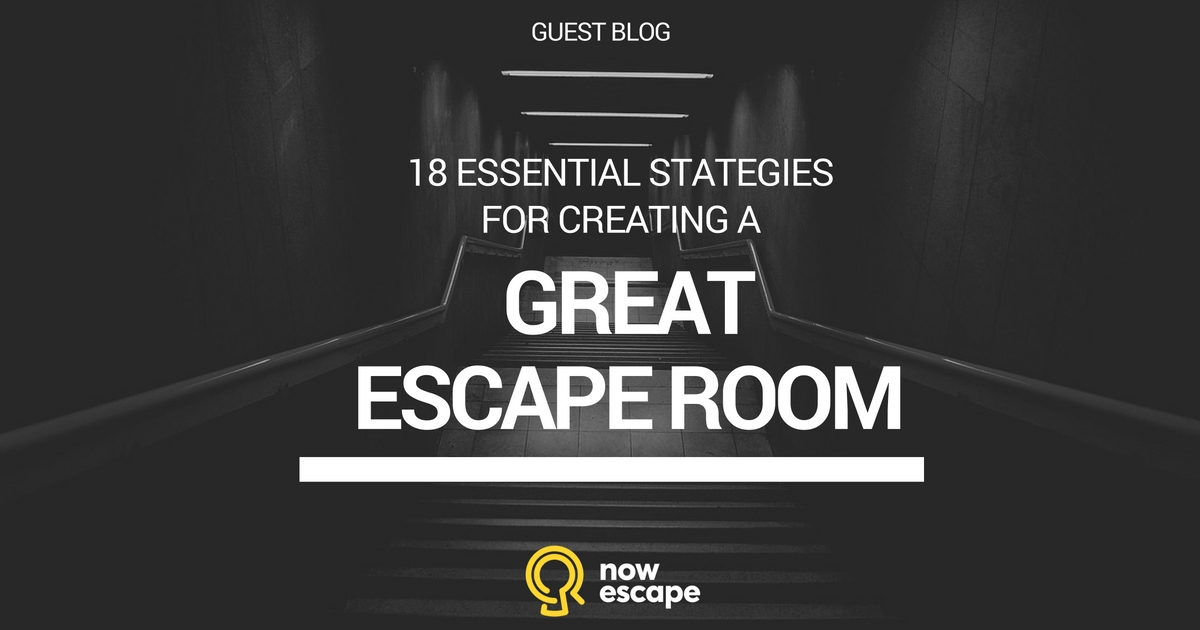
18 Essential Strategies for Creating a Great Escape Room
All great escape rooms have certain things in common.
Do you know what they are?
The fact is, anyone can open an escape room.
But not everyone opens a truly great escape room.
What’s the secret?
How can you take your escape room business to the next level?
In this guest post, Cathy Alexander, blogger for Escapologic – Escape Games Nottingham, provides escape game operators 18 proven ideas for enhancing their rooms and business practices and creating loyal customers who keep coming back for more.
Whether you’ve been operating your room escape business for a while or you’re just getting started, here’s how to “up your game” and turn a good escape room into a great escape room.
There are over 160 escape rooms in the UK, over 100 in Toronto, and 140 in Amsterdam. Exit games open and close every month.
Where do you start when it comes to making yours one of the success stories?
What actually makes a great escape room?
There are plenty of ideas included in this article. You’ll need to ask yourself a lot of questions and play as many escape rooms as you can before you set up your own.
The 18 tips below cover everything from creating a believable story to using tech, and keeping players engaged from start to finish. These are all things I’ve learned from working at a particularly immersive escape rooms for over a year.
1. Know your audience.
Do you want to be a family friendly venue? Are you interested in creating horror-based escape rooms? Exit games with high difficulty levels for enthusiasts? All of the above?
You’ve got to know your potential game players and their experience levels and possible expectations of the experience. Think carefully about the kind of player experience you want to provide. Know your audience and write to it.
2. Select an appropriate location.

Build up is important.
The building in which your escape rooms are located can help create an atmosphere from the outset.
There are constraints of course, but there’s something about descending steps that lead to subterranean rooms that’s far more exciting than climbing stairs to third floor offices.
It’s not just the rooms that should be dressed. A big sign bearing your logo on a magnolia wall won’t set the scene.
Theme your reception and corridors to match your brand. I’ve seen aged walls, old beat-up lockers, graffiti, and murals.
3. Write the story to fit your space.
You could come up with the most ingenious escape room ever created, but all plans will be scuppered if the story doesn’t suit the space.
Look at the possibilities of the space. Know its limitations.
You’ll need to storyboard the whole thing and treat it like a building project.
A good escape room is a construction piece.
4. Choose between a linear or a multilinear puzzle concept.
This should be determined by your space and story.
Linear is straightforward: solve a series of puzzles and get out.
Multilinear is by definition more difficult but arguably more intense if you get it right. Christopher Nolan’s Inception is often invoked as an example of incredible multilinear narrative.
Multilinear designs can have several paths that all lead to one point. That means you have more to think about, as you have to be able to tie them all together and bring it all back home.
5. Create a believable story.

Immerse your players in a narrative.
You need to build a believable story. In order to do that, you have to create a world, like in a computer game, a film or an absorbing book.
Take Harry Potter and A Game of Thrones. Both have engaging characters and a world in which everything from geography to tiny details has been carefully considered.
The whole thing has to be engaging and meaningful for the game players.
6. Know your main protagonist (if you have one).
The fact that you need to write an escape room makes you an author. And what do authors do? They tell stories with an intriguing main character.
This applies more to rooms of a certain type, like those based on the popular theme of a treasure hunter or explorer. Less so to what I would call a crisis situation room, like a nuclear bunker.
If you have a character, you need to know everything about him or her, from appearance and personality to favourite drink.
You won’t have to actually explain all this to the players, but you need to know it to make your story believable.
7. Design for optimal flow and pace.
A mystery needs to be at the heart of the room.
The design of an escape game should guide people through from point A to Z using a series of signposts. However, you need to keep the story flow going and make it well paced, like a video game.
You can do that by getting players to interact with what’s around them, whether it’s a grinning skull on a wall or a notebook full of strange symbols and equations. Also by increasing the difficulty level of the puzzles as you get closer to the exit point.
8. Make your puzzles interesting and challenging – but solvable.
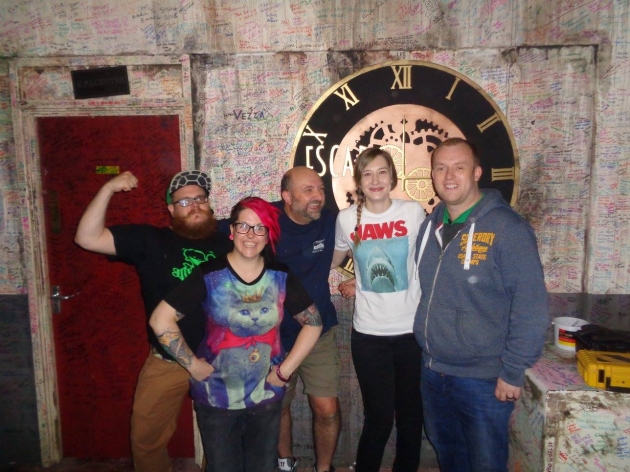
Players will not enjoy the game if they don’t regularly feel triumphant.
Players must be able to get out of the room in one hour.
Make something too obscure or difficult to find or solve, and you’ll suck all the fun out of the experience.
You need a good variety of puzzles.
Attention spans will wane if players simply have to open padlocks or find keys. A blend of logic, mathematical and creative puzzles that require a little outside-the-box thinking works well.
A puzzle that takes codebreakers and operators working in different parts of the room to open a door or gate is a good way to encourage teamwork.
Have a couple of people working on the actual codebreaking element and another two or three pulling levers or tapping out a message.
9. Make sure red herrings fit with the theme and narrative.
Escape rooms are basically mysteries that must be solved in order to win freedom. And what does every classic mystery possess? A red herring!
Now, this could be something as simple as objects that look like they should be vital but are actually just there for show.
I got fooled by a book that looked like it was full of essential information but actually wasn’t. It did fit with the theme and narrative though, so bear that in mind when considering use of red herrings.
Even red herrings have to be believable.
10. Give hints if and when needed, but never make it easy.
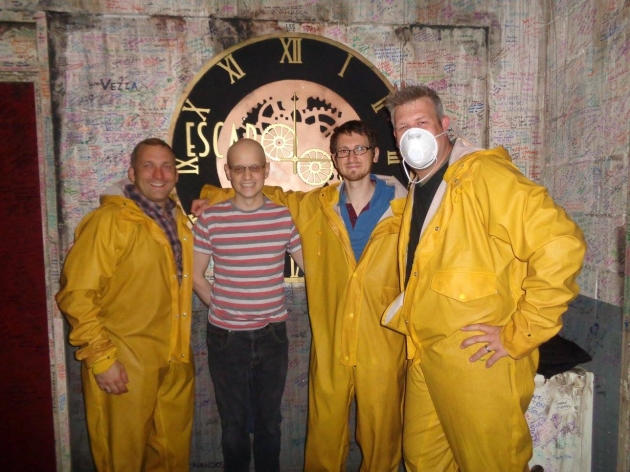
Hints should direct players toward the solution – not give them the solution itself.
Any hints you give have to work within the narrative or you’ll lose that all-important sense of immersion.
Remember that a hint is just that – a hint. Don’t spell out the answer for the players.
Players need to feel as though they’re solving everything with the minimum of help. They should have that sense of satisfaction from completing a challenge that will boost motivation and give them the momentum to go on to the next one.
11. Give nods to pop culture, games and films.
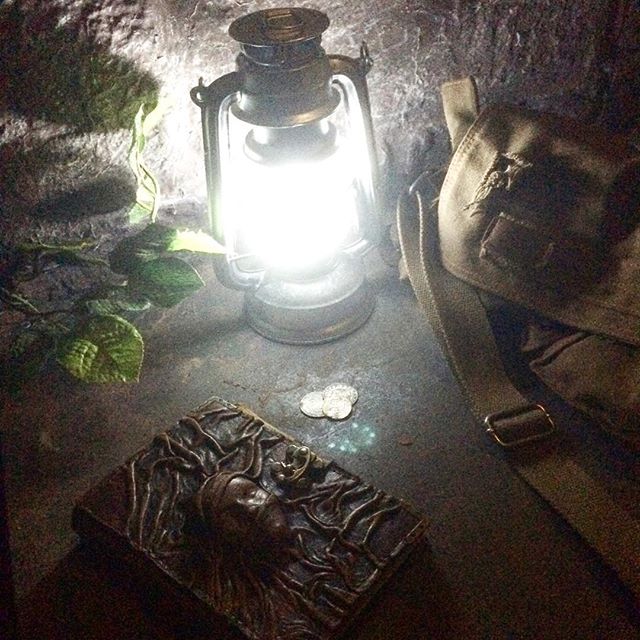
Escape rooms are all about escapism.
We’ve all seen Indiana Jones and James Bond. You might want to theme an entire room around one or the other.
Nods to popular culture create that feeling of playing out bits of a much-loved movie or game – fulfilling a fantasy – living it rather than just watching.
12. Make the entry and exit points different.
The big must!
Trying to figure out a way of opening the door you came in through gets old, fast.
Creating a labyrinth of doors, passages, chambers and rooms within rooms is the best possible scenario.
Secret doors within walls are good. Obviously this takes expertise. Don’t cut corners.
13. Make sure furniture, decor and props are consistent with the theme.
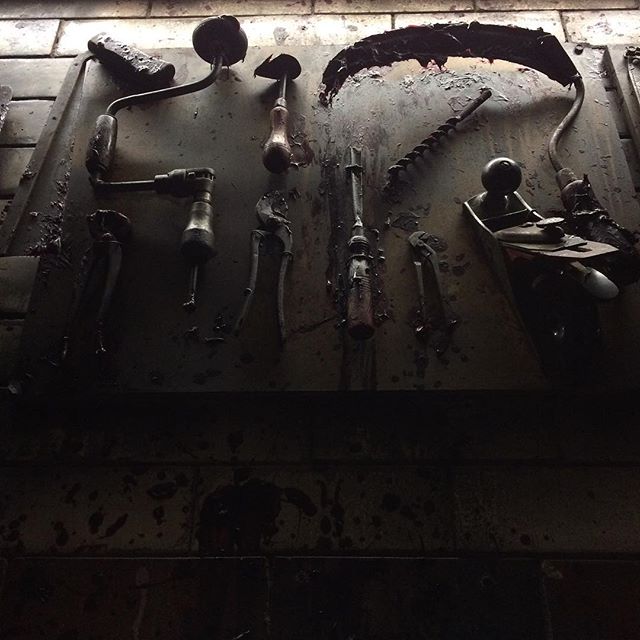
Your theme dictates the look and feel of the room, down to the tiniest detail.
A bunch of puzzles in a room is boring, even if they’re cleverly designed, fun to solve or addictive like Sudoku.
Theming needs to be consistent down to the last detail, particularly if it’s a period piece.
Anything that doesn’t quite fit will stick out like the proverbial sore thumb.
A good example of this is the animated Disney movie Robin Hood. It’s got a balloon in it, and I’m pretty sure they didn’t have balloons in the Middle Ages.
To tech or not to tech?
That is the question! Some rooms are loaded with tech. Others have none whatsoever.
The question of which route to traverse largely depends on how you’ve written the room.
Personally, I think the most inventive and engaging locked room games are the ones in which tech isn’t obvious. It’s always integrated into the set design.
Tablets in rooms
Another tech-related question: do you give players tablets so you can stay in touch with them?
That depends on the nature of the room. If doing so would adversely impact immersion, then no.
Constantly breaking the fourth wall worked for Deadpool. You are not Deadpool. If it’s a period piece I’d say no way. You’d need to use motion sensors and well-hidden cameras to keep an eye on your players.
Indiana Jones didn’t have a tablet when he was in the map room at dawn during Raiders of the Lost Ark.
Actors in escape rooms
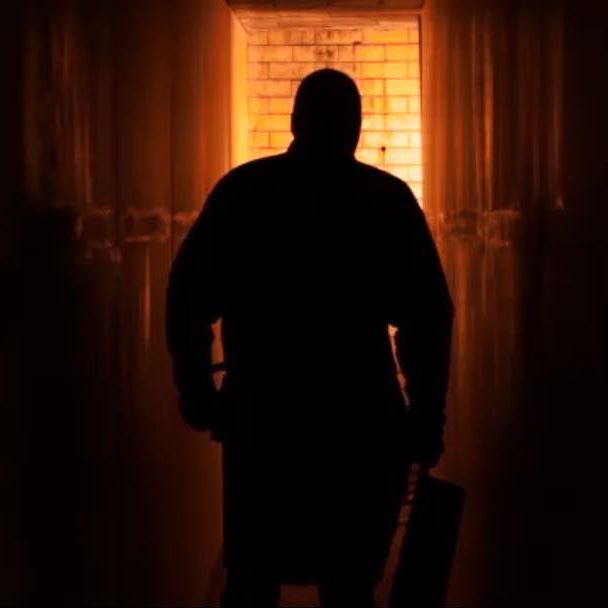
Actors are pretty much mandatory if you’re doing anything even remotely based on Texas Chainsaw Massacre or Saw.
This can and does work but again, it all depends on your backstory.
Actors don’t actually need to enter the room. Sound effects and the belief that ‘he’ is coming to get you is sometimes better than an actual presence. If you’re going down that route, it needs to be convincing.
Banging on walls, rattling, grunting, shouting; all that stuff. It needs an actor (or one of your staff) on the other side actually doing these things of course. More impactful than a recording.
A locked door
This is something of a bone of contention in the escape game world.
Some venues shut the door but don’t lock it. Others have a kind of ‘panic’ key to the point of entry for those who suddenly want to exit.
You might run into opposition from Health & Safety but there are properly locked room venues out there. You can’t beat this when it comes to total immersion and creating a sense of urgency in a race against time.
14. Create a feeling of total immersion.

Escape games are not just about puzzles.
Creating a feeling of total immersion is the holy grail of exit game design and creation. It takes an escape room from good to great. Achieving it takes time, imagination and expertise.
Escapism is all about interacting with the fantasy world you’re in. That means there must be things to find. I’ve had to open doors with no obvious keyhole using a toilet handle.
A treasure hunt element is a good way of getting people to engage with the room. Hiding things inside dark spaces or holes people must put their hands into ramps up the tension and gets the adrenaline going.
If you can, add sound effects.
If you can convince the people playing that the experience is actually real, you’ve really cracked it. That means everything from story to theming and your interaction with the players from outside the room has to be spot on.
That last point brings us nicely to …
15. Don’t run games remotely from a laptop in reception.
Interact with your players. React to them in real time. Be right behind the door.
Think of an escape room like a play. Your staff members are, in effect, stagehands, pulling strings, making sounds, triggering visual effects inside the room.
Make it nail biting.
The players must feel like time is running out.
16. Keep players guessing until the very end.
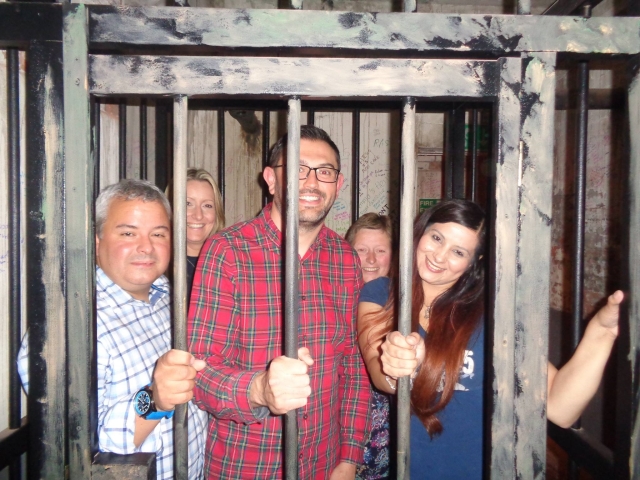
Players shouldn’t know how far they are from the end at any point.
Exit games work on the element of surprise. Those surprises need to keep on coming until the end.
Failure can be ok.
If absolutely everyone who plays a game can exit in under 25 minutes then you might want to question its quality. The great thing about this experience is that you don’t have to ‘smash it’ to have fun.
I’ve failed to get out of rooms but still had a great time playing the game.
17. Make your marketing as unique and exciting as your rooms.
This is a post in its own right but it’s a vital consideration when thinking about what makes a good escape room.
‘Coming Soon’ teaser trailers for social media are good.
Golden tickets that allow free player spaces for an escape room that’s just opened are also well worth considering. I know one escape room owner who ended up generating business the old fashioned way: by simply going out on the street and giving these out. It creates a sense of anticipation.
Don’t give it all away on your website.
The blurb of a book doesn’t tell you the whole story. Same rule applies here. In this game, knowing too much about what to expect ruins the experience.
It needs to be a journey that starts before players have even entered the building.
And don’t oversell in terms of experience and difficulty rating. You’ll be outed on TripAdvisor.
18. Resist temptation to jump on a bandwagon.
I’m talking about virtual reality here. There has been much talk of VR in the future of escape rooms. But the technology isn’t quite there yet.
See how Oculus Rift is received and reviewed by people who’ve actually bought it before you get on board.
Now go create the best escape game you can imagine!
Excited much?
You should be!
There’s a lot to think about here and it’s all good. Try to think about one thing at a time rather than everything on the list at once. Pick your space first and go from there. Break tasks right down.
Remember the golden rule: be imaginative. Don’t hold back. Escape game players will remember the room that really captured their imaginations and transported them to another world. Get out there and create it!
About the Author
Cathy Alexander blogs for Escapologic, with the most immersive escape rooms. Located in the Lace Market, these hyper realistic, subterranean rooms vary in theme and difficulty level. There are currently five rooms with a sixth coming very soon.
High production values, believable narratives, engaging puzzles, locked doors, and welcoming staff who run each game from right behind the wall have earned Escapologic a slew of 5-star ratings on TripAdvisor. The rooms are open 7 days a week.
Enter the 13utcher’s lair and see if you can escape before he comes back to finish who he started …
Con-trap-tion is fiendishly clever! Patterns, codes and clues unlock the secrets of the room but you’ll need to work fast and smart to suss out the machines and gadgets created by our ingenious inventor.
Howitz is the tragic tale of a toy shop owner driven towards dark forces by grief. Can you find out what happened before the sands of time run out?
Crypt-ic follows in the footsteps of legendary explorer Crispin Sheppard who mysteriously disappeared many years ago. A rip-roaring, Indiana Jones-style adventure with fun mental and physical puzzles.
E.P.I. Centre is a top chemical research facility in a city that’s been hit by a massive earthquake. As part of the disaster cleanup crew, your job is to rescue the priceless chemical sample while systems fail and machines shut down.
For more expert tips, check out Escape Design Guru Reveals 13 Secrets.
Just getting started? You’ll find what you’re looking for in How to Open Your Own Escape Room: A Simple 22-step Guide.
Tags: guest blog




2 Comments
Can’t agree more on the pop culture references. You can even use them as secondary clues to help teams solve a puzzles. E.g. a well known Simpsons quote on a donut. These can’t be the main/only clue but really make players feel like pro’s if they have the background knowledge to make the connection
Hi Cathy, thanks for the great blog. I am working on starting our own escape room with a friend and we are brainstorming for concepts on our room design.
Funny you mention incorporating pop culture in room designs. We were thinking of designing a room that’s “inspired” by a TV show – Lost. We agreed that we can come up with interesting puzzles and narrative with elements of the show in it.
Anyways, long story short, we saw a post on an escape room fan page on facebook that got us discouraged from that concept due to any copyright infringement traps we may fall in.
Are we overthinking it here? We simply wanted the show to inspire us. We wanted to design the stage and props that relate to the show but as a narrative it is completely our own. Puzzles is all our imagination but in someway designed to relate to the show. we were going with “easter eggs” approach where fans of the show might find it cool.
Can you let me know what you think? Is there a stigma to design a room inspired by a popular TV-show/movie/book/ game etc..
Really interested to hear your thoughts on this.
Thanks,
Hikmat